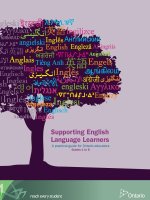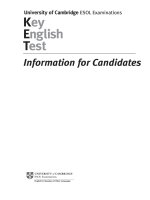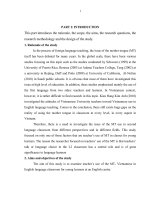Cambridge English - Young Learners Information for candidates
Bạn đang xem bản rút gọn của tài liệu. Xem và tải ngay bản đầy đủ của tài liệu tại đây (2.5 MB, 9 trang )
Information for candidates
and parents
www.cambridgeenglish.org/younglearners
About
the tests
Preparing
After
the test
22
Test day
Information for candidates andparents
Dear Parent,
In the next eight pages you will find all the information you
need to help your child prepare for the Cambridge English:
Young Learners tests: Starters, Movers and Flyers.
You will find out about what is in the tests and what your
child needs to be able to do. There is also advice on how to
prepare for the test and tips for the day of the test. There is
information about what happens after the test, too.
Please read this information and share it with your child.
You can print this document, but it is better to use it
online, because there are links to tests, videos and other
usefulinformation.
Best wishes,
Cambridge English
Language Assessment
About the Cambridge English: Young Learnerstests
The Cambridge English: Young Learners tests are produced by Cambridge English Language
Assessment (part of the University of Cambridge). These tests are for learners in primary
and lower secondary education. Starters, Movers and Flyers are part of the range of Cambridge
Englishexams.
The tests are designed to make
a child’s early language learning
experience positive and fun. Parents
can therefore think of the Cambridge
English: Young Learners tests as a
way to help their children enjoy
learning as well as increase their self-
confidence and languageskills.
Many children take Cambridge
English: Young Learners tests at
their school. Your local Cambridge
English exam centre can give you
all the information you need about
registering children for the test,
including entry costs anddates.
x Find your nearest
exam centre
x Visit our website for information on taking Cambridge English:
Young Learners on computer or selected tablets
x View the range of
Cambridge English
exams
About
the tests
Preparing
After
the test
33
Test day
Skill Part Task Action
Listening
20 minutes
1 Match objects outside a
picture with the place they
should go inside a picture.
Draw lines.
2 Answer questions about a
child or an animal.
Write names or numbers.
3 Choose the picture with
the correct information.
Tick boxes.
4 Choose an object in a
picture and a correct
colour.
Colour objects in a picture.
Reading and
Writing
20 minutes
1 Decide if pictures match
the words next to them.
Put ticks or crosses.
2 Decide if a picture
matches sentences about
it.
Write yes or no.
3 Use given letters to name
objects in pictures.
Spell words.
4 Choose correct words to
fill gaps in a short text.
Copy words.
5 Answer questions about a
picture story.
Write words or numbers.
Speaking
3–5 minutes
1 Find things in a big picture. Point to objects.
2 Choose correct object
cards and understand
prepositions.
Place object cards.
3 Give short answers to
questions about a big
picture.
Name objects, colours
and say numbers.
4 Give short answers to
questions about objects.
Name objects, colours
and say numbers.
5 Answer questions about
you.
Give short answers.
Here is a summary of the three tests:
Starters
Total length = approximately 45 minutes
P
P
O
Alex
spelling
yes
12
x Download sample Cambridge English: Starters exam papers
x See the Speaking test video
x Read an examiner’s comments on the Speaking test
x Download the Cambridge English: Starters Word List Picture Book
copy
copy
About the tests
About
the tests
Preparing
After
the test
44
Test day
Skill Part Task Action
Listening
25 minutes
1 Match names outside a
picture with the people
that are inside a picture.
Draw lines.
2 Answer questions about a
place, trip, party etc.
Write words and numbers.
3 Match days of the week
with dierent activity
pictures.
Draw lines.
4 Choose the picture with
the correct information.
Tick boxes.
5 Choose the right parts of
a picture and understand
colouring and drawing
instructions.
Colour parts of a picture.
Draw something.
Reading and
Writing
30 minutes
1 Match pictures/words
with describing sentences.
Copy words.
2 Decide if a picture
matches sentences about
it.
Write yes or no.
3 Choose the right answer
to questions.
Circle a letter.
4 Choose correct pictures/
words to fill gaps in a short
story and the correct title
for the story.
Copy words and tick a box.
5 Find words in a story to
complete sentences.
Copy 1, 2 or 3 words.
6 Choose the right words to
fill gaps in a short text.
Copy words.
Speaking
5–7 minutes
1 Find dierences between
two pictures (objects,
colours, numbers,
positions etc.).
Say what is dierent.
2 Talk about pictures that
tell a story.
Say short sentences.
3 Choose a picture that
is dierent from three
others.
Say how it is dierent.
4 Answer questions about
you.
Give short answers.
Movers
Total length = approximately 65 minutes
P
12
yes
copy
copy
dog
copy
copy
copy
copy
copy
copy
x Download sample Cambridge English: Movers exam papers
x See the Speaking test video
x Read an examiner’s comments on the Speaking test
x Download the Cambridge English: Movers word list
P
About
the tests
Preparing
After
the test
55
Test day
Skill Part Task Action
Listening
25 minutes
1 Match names outside a
picture with the people
that are inside a picture.
Draw lines.
2 Answer questions about a
place, trip, party etc.
Write words and numbers.
3 Match people or objects
in one set with pictures of
objects in another set.
Write letters in boxes.
4 Choose the picture with
the correct information.
Tick boxes.
5 Choose the correct
parts of a picture and
understand colouring,
drawing and writing
instructions.
Colour parts of a picture.
Draw and write something.
Reading and
Writing
40 minutes
1 Match words with
describing sentences.
Copy words.
2 Decide if a picture
matches sentences about
it.
Write yes or no.
3 Choose the correct
missing parts of a
conversation.
Write a letter.
4 Choose correct words to
fill gaps in a short story
and the correct title for
the story.
Copy words and tick a box.
5 Find words in a story to
complete sentences.
Copy 1, 2, 3
or 4 words.
6 Choose the right word to
fill gaps in a short text.
Copy words.
7 Think of words to
complete a diary or
message text.
Choose and write words.
Speaking
7–9 minutes
1 Find dierences between
two pictures (objects,
colours, numbers,
positions, actions etc.).
Say what is dierent.
2 Ask for and give
information about two
similar situations.
Ask and answer questions.
3 Talk about pictures that
tell a story.
Say sentences.
4 Answer questions about
you.
Give short answers.
Flyers
Total length = approximately 75 minutes
12
b
yes
a
P
write
copy
copy
copy
copy
copy
copy
copy
copy
x Download sample Cambridge English: Flyers exam papers
x See the Speaking test video
x Read an examiner’s comments on the Speaking test
x Download the Cambridge English: Flyers word list
P
6
About
the tests
Preparing
After
the test
Test day
Preparing for Cambridge English: Young Learners
Here are some things that your child should practise doing to prepare for Cambridge English:
Young Learners.
x Download the Starters word list
x Download the Movers word list
x Download the Flyers word list
At all levels (Starters, Movers and Flyers) candidates
need to be able to:
• understandthewordsonthewordlistfor
theirtest
• spellthewordsonthewordlistcorrectly
• usepresentsimpleandcontinuoustenses
(e.g. ‘I go’ and ‘I am going’)
• understanddescriptionsofpeople(what
someone is doing, what they are wearing and
what they look like)
• understandprepositions(forexample,to
understand where people and objects are in
pictures)
• writewordsthatarespelledforthemandother
words that they hear
• copywordstocompletetexts
• understandsentencesthatdescribepicturesand
also speak about what they see inpictures
• followcolouringinstructions
• askandanswersimplequestions.
At Starters, they also need to be able to:
• lookatsomejumbledletters,andputthemin
order to make a word that matches apicture.
At Movers and Flyers, they also need to be able to:
• usepastsimpletenses(e.g.‘Iwent’)
• talkaboutwhatishappeninginapicturestory
• talkaboutthedierencesbetweentwopictures.
At Flyers, they also need to be able to:
• usethepastcontinuous(e.g.‘Iwasgoing’)and
future forms (‘going to’ and ‘will’).
Our Parents’ Newsletter
The Cambridge English Parents’ Newsletter has activities, tips
and articles to help you help your child learn English.
x Sign up here
7
About
the tests
Preparing
After
the test
Test day
Preparing to take the test
You want your child to feel as confident as possible on the day of the test. What can you do
to help?
• Makesureyourchildknowstheimportantinformationinthisdocument,looksatthe
pictures that show what to do in the exam and tries the sample test papers. When
children know what to expect, they will feel more confident and prepared.
• Mostcandidateswillprobablypreparefortheir
test in English classes at school, but they can
also practise at home. This can help them feel
more confident. With your help, your child can
find answers to their questions about the test or
think of questions to ask their teacher about the
test. You can also help them learn and perhaps
give them short tests to encourage them.
In the Listening test:
• Therecordingsareplayedtwice.Ifcandidatesmiss
something the first time they listen, there will be another
chance to hear the answers.
• Itisn’timportanthowwellcandidatescolourordrawpartsof
a picture. They just need to find the right part of the picture,
use the right colour and make a drawing recognisable.
In the Reading and Writing test:
• Itwillbehelpfultomakesureyourchildcan
writeclearly.
• Answersaregenerallyveryshortandwordscan
most often be copied from a word box or from
parts of the text, so candidates don’t need to write
complete sentences.
In the Speaking test:
• Examinersarehelpfulandfriendly.Theyare
experienced and encouraging people. Candidates
should try to relax and enjoy this part of the test.
Suggest they try to use phrases that they know
for communicating, for example, ‘Good morning’,
‘Pardon?’ ‘Yes, please’, and ‘thank you’.
• Ifcandidatesdon’tunderstandsomething,theycan
ask the examiner to repeat what they said. Suggest
they say: ‘Sorry, can you say that again?’
Visit our website for
x more about Cambridge English: Young Learners exams
x more information for parents
x free online learning games
Good morning
8
About
the tests
Preparing
After
the test
Test day
The day of the test
On the day of the test, your child will probably be excited and nervous. Remember that the
test is designed to reward what your child can do in English and to be enjoyable – nobody fails
the test.
EXAM DAY TIPS
Candidates should:
P go to bed early the night before the test
P have lots of time to get ready so they don’t need to hurry
P have a good, healthy breakfast
P not try too hard to study, at home or at school, just
before the test – try to keep the atmosphere calm
P go to the toilet before the test
P take some water to drink
P listen carefully to the examiner’s instructions and to the
recordings
P read all the instructions and questions carefully before
they start each part of the test
P know they must not talk to the other candidates during
the test
P know they can raise their hand in silence if they need to
ask a question
P know they must not ask questions during the
Listeningtest
P remember to check their work and spellings when they
have finished
P try to write an answer to all the questions even if they
don’t know the right one
P remember this test has the same types of questions as
their practice tests so there will be no surprises.
About
the tests
Preparing
After
the test
Test day
Cambridge English
Language Assessment
1 Hills Road
Cambridge
CB1 2EU
United Kingdom
www.cambridgeenglish.org/help
© UCLES 2013 CE/1818/3Y11
I’ve taken two of the Cambridge
English: Young Learners tests and
won many little shields. My English
has become better and better, and I
love CambridgeEnglish!
Huang Yaozu
Champion of the 2010 China YLE
speaking competition– Movers,
Dongguan Nancheng Mingshiyuan
Training School,China
After the test
All candidates who complete Cambridge English: Young Learners tests receive a certificate.
There is no pass or fail result.
Every child who takes the test should feel they have achieved something important.
On their certificate, candidates will see shields for
Listening, Reading and Writing, and Speaking. The
maximum score for each is five bold shields. One
bold shield means that the child took the test but
can still improve a lot in this part of the test. Five
bold shields mean that the child did very well in
this part of the test.
A total score of 10 or more bold shields shows
that the child is ready to start preparing for the
next Cambridge English test.
Certificates usually arrive three to four weeks after the test or earlier. If you need to check
when your certificate will arrive, contact the exam centre.
What happens next?
Cambridge English exams are for every stage in learning English, and the Cambridge English:
Young Learners exams are just the first steps. Cambridge English: Key for Schools is at Level A2,
like Cambridge English: Flyers, but it is for learners in secondary education, and it tests slightly
dierent skills (for example, candidates need to write more in Cambridge English: Key for
Schools). The next exams are Cambridge English: Preliminary for Schools and Cambridge English:
First for Schools, then learners can go on to take Cambridge English: Advanced and Cambridge
English: Proficiency.









